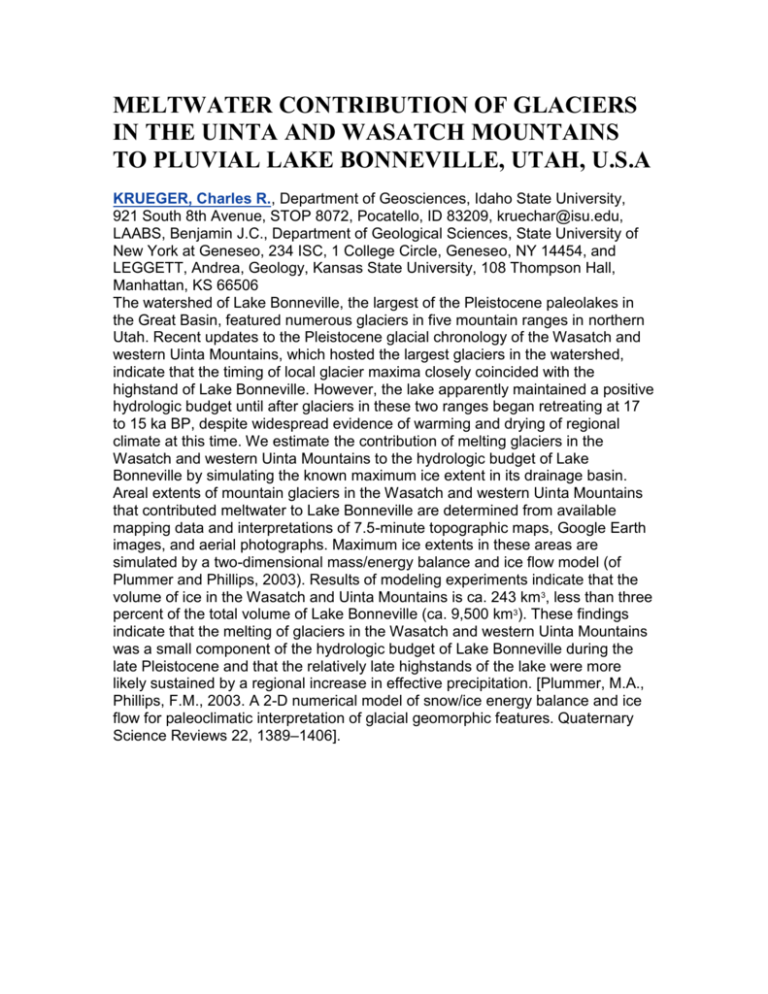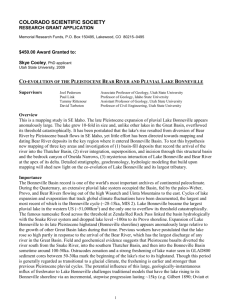GSA2011_Bonneville_Abstracts
advertisement

MELTWATER CONTRIBUTION OF GLACIERS IN THE UINTA AND WASATCH MOUNTAINS TO PLUVIAL LAKE BONNEVILLE, UTAH, U.S.A KRUEGER, Charles R., Department of Geosciences, Idaho State University, 921 South 8th Avenue, STOP 8072, Pocatello, ID 83209, kruechar@isu.edu, LAABS, Benjamin J.C., Department of Geological Sciences, State University of New York at Geneseo, 234 ISC, 1 College Circle, Geneseo, NY 14454, and LEGGETT, Andrea, Geology, Kansas State University, 108 Thompson Hall, Manhattan, KS 66506 The watershed of Lake Bonneville, the largest of the Pleistocene paleolakes in the Great Basin, featured numerous glaciers in five mountain ranges in northern Utah. Recent updates to the Pleistocene glacial chronology of the Wasatch and western Uinta Mountains, which hosted the largest glaciers in the watershed, indicate that the timing of local glacier maxima closely coincided with the highstand of Lake Bonneville. However, the lake apparently maintained a positive hydrologic budget until after glaciers in these two ranges began retreating at 17 to 15 ka BP, despite widespread evidence of warming and drying of regional climate at this time. We estimate the contribution of melting glaciers in the Wasatch and western Uinta Mountains to the hydrologic budget of Lake Bonneville by simulating the known maximum ice extent in its drainage basin. Areal extents of mountain glaciers in the Wasatch and western Uinta Mountains that contributed meltwater to Lake Bonneville are determined from available mapping data and interpretations of 7.5-minute topographic maps, Google Earth images, and aerial photographs. Maximum ice extents in these areas are simulated by a two-dimensional mass/energy balance and ice flow model (of Plummer and Phillips, 2003). Results of modeling experiments indicate that the volume of ice in the Wasatch and Uinta Mountains is ca. 243 km 3, less than three percent of the total volume of Lake Bonneville (ca. 9,500 km3). These findings indicate that the melting of glaciers in the Wasatch and western Uinta Mountains was a small component of the hydrologic budget of Lake Bonneville during the late Pleistocene and that the relatively late highstands of the lake were more likely sustained by a regional increase in effective precipitation. [Plummer, M.A., Phillips, F.M., 2003. A 2-D numerical model of snow/ice energy balance and ice flow for paleoclimatic interpretation of glacial geomorphic features. Quaternary Science Reviews 22, 1389–1406]. TESTING AND REFINING THE TIMING OF HYDROLOGIC EVOLUTION DURING THE LATEST PLEISTOCENE REGRESSIVE PHASE OF LAKE BONNEVILLE SPENCER, Joel Q.G.1, OVIATT, Charles1, PATHAK, Manas2, FAN, Yuxin3, and LEGGETT, Andrea1, (1) Geology, Kansas State University, 108 Thompson Hall, Manhattan, KS 66506-3201, joelspen@ksu.edu, (2) Geology, Indian School of Mines, Dhanbad, 826004, India, (3) MOE Key Laboratory of Western China's Environmental Systems, Lanzhou University, Lanzhou, 730000, China Lacustrine, fluvial, and wetland landforms present in the now desertified regions of Dugway Proving Ground (DPG) and the Sevier Desert (SD) in western Utah, record a fascinating history of falling lake level, river development, and establishment of wetland habitats in the Lake Bonneville basin between ~14-8 ka ago. This was not only a time of rapid climate change but also of human occupation into suitable habitats made available by decline of the large lake. Using optically stimulated luminescence (OSL) dating methods we are determining depositional ages for sediment samples from bar features (reworked deltaic sands), braided fluvial channels, and topographically inverted fluvial channels collected from DPG during prior fieldwork. These data will be compared to existing chronological evidence from DPG and SD to test and refine the timing of changes in the geologic environment during this stage of Lake Bonneville regression. Accurate assessment of the timing of the hydrological and geomorphological changes taking place during the late regressive phase of Lake Bonneville will help determine the relative importance of environmental change compared with groundwater discharge thought to accompany falling lake levels. PLUVIAL LAKES IN THE WESTERN U.S.—A VIEW FROM THE OUTCROP REHEIS, Marith, U.S. Geological Survey, Box 25046, MS 980, Denver Federal Center, Denver, CO 80225, mreheis@usgs.gov Huge strides have been made during the last 40 years in deciphering the geologic and climatic records of Pleistocene pluvial lakes in the western U.S. using cores from extant lakes and from desiccated lakes such as Lake Bonneville and Owens (dry) Lake. Sedimentology, stable isotopes, pollen and other microfossils, and physical properties from cores provide proxies for changes in lake level, water temperature and chemistry, and ecological conditions in the surrounding landscape. Commonly, such core data do not directly record lake level or reveal geologic factors that may confound interpretations of proxy data, and most core records do not extend beyond the last ~40 kyr. In contrast, outcrop studies of incised basin fill provide much longer lake histories, indicate absolute lake level, and yield clues to geologic events such as earthquakes, floods, or drainage-basin changes that can clarify interpretations of lake sediment and stratigraphy. Notable advances made using outcrop studies include recognition of: (1) many pre-late Pleistocene lakes in the western Great Basin that were significantly larger and record wetter conditions than the youngest lakes; (2) drainage-basin changes caused by tectonic or volcanic damming, in some cases triggering lake overflow or catastrophic floods and altering the depositional setting of previously deep-water locations; (3) complex relations among basins and subbasins controlled by changing threshold altitudes; and (4) rapid lake-level fluctuations in dated records. Combined outcrop and core data from Lake Manix yield a 500-kyr lacustrine history indicating persistent lakes during both glacial and interglacial periods, and recognition of significant change in depositional setting of the core by a drainage integration event. Outcrop studies should be coupled with core data to provide the most comprehensive understanding of lake records of environmental change. IDENTIFYING SUITABLE TERRESTRIAL ANALOGS OF MARS SHOREZONE FEATURES: PLANETARY EXPLORATION GUIDELINES JEWELL, Paul1, CHAN, Marjorie1, NICOLL, Kathleen2, PARKER, Timothy3, OKUBO, Chris H.4, KOMATSU, Goro5, ORMO, Jens6, and BARKER, Donald7, (1) Dept. of Geology and Geophysics, Univ. of Utah, 115 S. 1460 E. Rm 383 FASB, Salt Lake City, UT 84112, paul.jewell@utah.edu, (2) University of Utah, 260 South Central Campus Dr, Salt Lake City, UT 84105, (3) Jet Propulsion Laboratory, California Institute of Technology, 4800 Oak Grove Drive, Pasadena, CA 91109, (4) Astrogeology Science Center, US Geological Survey, 2255 North Gemini Road, Flagstaff, AZ 86001, (5) Irsps, Univ. G.d'Annunzio, Viale Pindaro, 42, 65127, Pescara, Italy, (6) Centro de Astrobiologia, Torrejon de Ardoz, 28850, Spain, (7) Earth and Atmospheric Sciences, University of Houston, 312 Science & Research Building 1, Rm. 312, Houston, TX 77204 The nature or even the past existence of a large water body on Mars has been the subject of intense controversy and is a driving force behind selection of future exploration sites on the Red Planet. Whatever the nature of Martian oceans or lakes, they were almost certainly subjected to physical forcings and climate with no direct analog in Earth’s geologic history. Nevertheless, any large body of water that remains in the same place for an extended period of time invariably leaves a physical record of its presence at the water-atmosphere interface. In the case of oceans and large lake shorezones on Earth this record includes shorelines, strandlines, beach ridges, and other physical manifestations. Recognition of these features depends on their geomorphic expression (length, relation to surrounding topography) and sedimentary character (textures, structures, or chemical deposits such as tufa). For many years to come, recognition of possible shorezone features on Mars must rely on remote sensing instruments that in turn will be a function of the spatial resolution and spectral capabilities of these instruments and relating the resulting images to Earth analogs. Unfortunately, a large percentage of appropriate shorezone Earth analogs are (1) too subtle or small to be detected by currently deployed Martian instrumentation or (2) distinguished by vegetation patterns which in turn are a function of the sedimentary characteristics of the substrate and thus are not appropriate analogs for the modern surface of Mars. Appropriate Earth analogs for Martian shorelines must necessarily be restricted to a narrow suite of shoreline features. Specific examples from ice age water bodies Lake Bonneville, Lake Agassiz, Baltic Ice Lake and the modern Great Lakes provide guidelines for recognizing shorezone features on Mars and should guide the search for paleo-oceans and paleo-lakes on the Red Planet.










